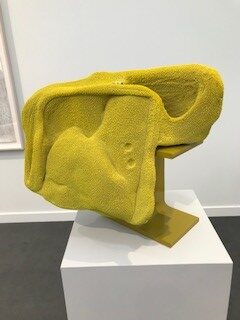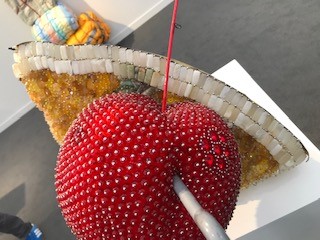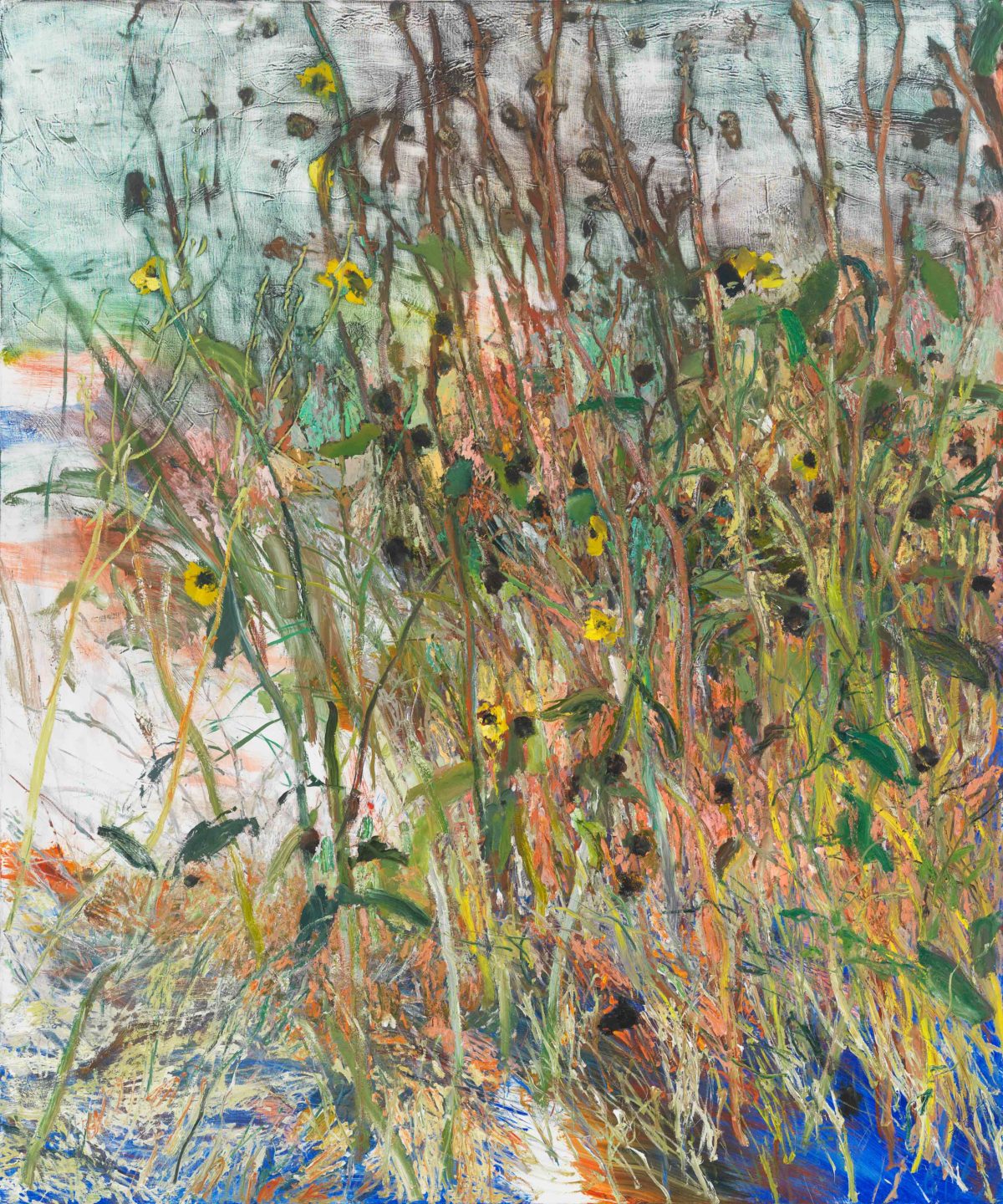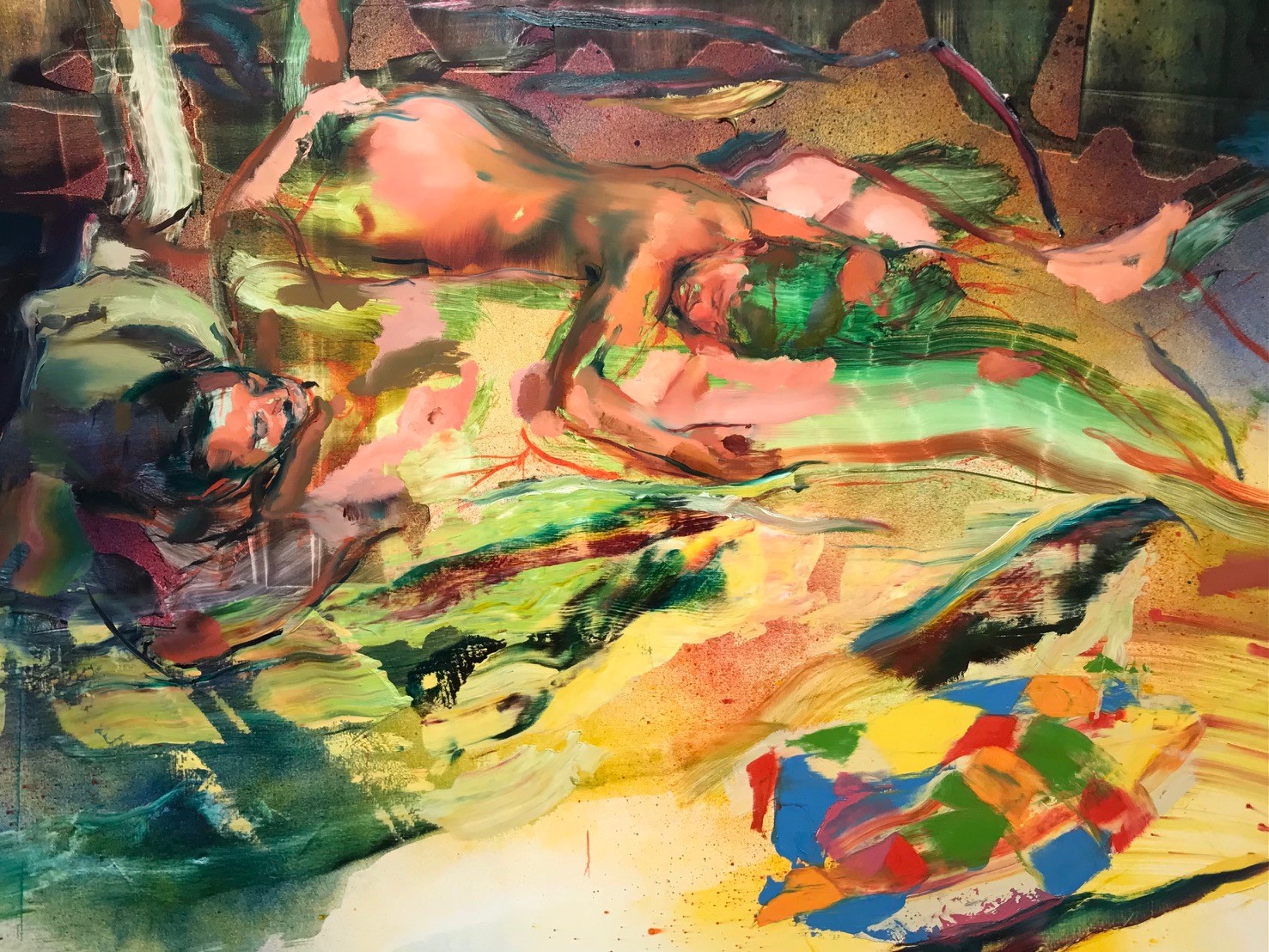Let me start by just getting a few things off my 28AA chest. I didn’t make it to ANY of the satellite Frieze Projects and am particularly upset about missing at least two of them—specifically Kelly Akashi’s project, Heirloom at the Villa Aurora (last week’s Pick of the Week), and W(hole), an intended partial exhibition or selection of works from what would become Julie Becker’s last body of work. (Although now that I think of it, it occurs to me that this particular exhibition might still be up—since it’s the one that’s actually on the Del Vaz Projects premises (Shirley Temple’s childhood home in Santa Monica).) The projects were curated by Jay Ezra Nayssan (Del Vaz is his own home-based curatorial project). It’s true that, in theory, I might have made it to one or two of them on my own. But seriously, given the number of art-related events scheduled that week, setting aside three full-blown fairs to go through, setting aside just … work … schedule … life…. (oh, and have I mentioned traffic? yeah….)—would it have killed you to keep them open for a month or so? The point being that Pacific Palisades and the Brentwood-adjacent portions of Santa Monica are not exactly within walking distance of the Santa Monica Airport. Or even biking distance. Or—under 2023 L.A. driving conditions—driving distance. (And not-so-incidentally would it kill you to invite your faithful correspondent to the media preview brunch next time?)
So the usual, not-so-usual, and a surprising number of never-usual-and-truly-extraordinary suspects (L.A. can be counted on to deliver in that last category) showed up, along with the usual on-lookers and troublemakers (myself included). And—this may sound funny for L.A.—but, whatever the minute-by-minute mood fluctuations through the fair, by and large we weren’t kidding around. (But then no one has time for that anymore.) Frieze was serious, too—this was by far the largest edition of the fair to hit Los Angeles, easily eclipsing ANY other art fair to ever hit the city—not at the scale of Frieze London (which also includes Frieze Masters), nor say, The Armory Show, but enough to justify return visits without becoming a blur (frankly a problem with those megalopolis convention center layouts). A lot of people in and around the so-called art world claim to dislike fairs, preferring to sample from their local (and/or New York and London) favorites and newbies, and dive in more or less randomly wherever their air miles accumulate and their carbon footprints start getting embarrassing. Art Basel can be intense; and Art Basel Miami Beach is—well, maybe closer to Animal Farm than a ‘zoo’, per se—truly an industrial enterprise. But I like magazines, and for me the best art fairs are like stand-up magazines where it’s the September, Holiday and Spring issues combined—fat with all the ads (always guaranteed to gladden a free-lancer’s heart). I wasn’t there to survey the attendees (have to assume Christine Messineo and her team are on that), but can safely say that amongst a random sampling of colleagues, collectors, artists and assorted pals and contacts, the impression was pretty favorable overall.

Christina Forer, “Regula ZH” (2021)
This is not the usual buzz that comes back amongst media-ettes. But, as I said, no one was fooling around. It was impossible not to notice the prominent placement of the major L.A. galleries—but my focus was more on the, uh, “Focus” group of galleries that were featured in the Barker Hangar (which for this fair played back-up to the main WHY-designed pavilion). They included a number of younger L.A. galleries, including Chris Sharp, who showed Edgar Ramirez—whose work hardly needed to be singled out for acquisition by Santa Monica to stand out here. But there was quite a bit of strong work to go around—from Seoul (Johyun Gallery—with Lee Bae’s Issu du feu 8P (1998—though it looked startlingly contemporary) to Parrasch Heijnen, who, to my surprise, brought more L.A. Cool School classics (though still strikingly contemporary) than work more representative of their current artists and shows, which is just as strong. There was a lot of woven and textile work throughout the fair, and here the vivid and strikingly animated work of Christina Forer at Luhring Augustine stood out.

Arlene Shechet, “Together Again: Fall” (2022)
In the main tent, the Kaiserin—Kim Dingle’s (deserved) honorific for her gallerist, Susanne Vielmetter, ‘won’ the L.A. contingent of the fair—simply by keeping the focus sharp and bringing the best, liveliest work—specifically, Nicola Tyson’s dreamy abstracted drawings—seemingly mapped out configurations of gesturing faces (or masks) and figures, and Arlene Shechet’s brilliant chromatic, vari-textured ceramic and steel sculptures—which might just as well be another life form. (Why not? With all the other life forms going extinct, we better dream up a few new ones.) I will say, I liked Maia Ruth Lee’s Bondage Baggage over at Ghebaly (has she been spying on me at airport baggage carousels?) and Kathleen Ryan’s cocktail garnishes (e.g., Bad Fruit (Tom Collins)—gorgeous—and genius).

Kathleen Ryan, Bad Fruit (Tom Collins), 2022 (with Maia Ruth Lee, “Bondage Baggage” in background
While Kathleen Ryan has me thinking about maraschino cherries, lime wedges, and the two Sevillano Queen olives I insist upon in my (children’s size) Bombay Sapphire martini, let me take note of another distinction about this edition of Frieze L.A. (in very sharp contrast to last year’s Beverly Hilton romp): FOOD, glorious food. I was steeling myself for the worst. No—they still won’t comp you a glass of Champagne or an espresso, but here’s the thing: it was there, and it was relatively easy to get. And. Then. There. Was. Food. Thai food, pizza, panini, tacos, beverages—good quality and all reasonably priced. (Not the Champagne, though.) This is important because whether we realize it or not, after slogging through city traffic, the parking gauntlet (kill me now), or just street parking (which, if you had two functioning brain cells you figured out), and two or three hours straight of cruising and schmoozing, you are very likely dying of hunger.

Doron Langberg, “Sunflowers” (2022), courtesy the artist & Victoria Miro Gallery
So let me cut to the chase right now and just say that Victoria Miro (London) won the fair. It’s one thing for a gallery’s featured (or ‘focus’) artist to make a splash with a signature installation or a suite of works that constitute a breakthrough transition. Certainly that happened here. But in addition to that artist—Doron Langberg—who commanded the space and eclipsed half of what was happening in the adjacent gallery spaces with his exuberant, rapturous painting, there was nothing on offer through the rest of the space that would not be prized, coveted, leave you breathless—from a genius Chris Ofili watercolour to a pair of Chantal Joffe portraits to another pair of Wangechi Mutu collages. Don’t make me go on because I’ll be sick—in the bad way that means the art was that good.
Doron Langberg may be new to me, but that means nothing. What’s hard to believe is not that I miss stuff (it’s impossible not to—and that’s a good thing); what’s odd is that even for us West-coasters, this Brooklyn-based artist has been quite visible for at least a couple of years. Which I would have known if my Times carrier (both Los Angeles and New York) had actually delivered my April 2021 T Magazine along with the rest of that Sunday’s New York Times (how’s that for a rant within a rant?—seriously it’s a problem), in which he was featured alongside another artist, Salman Toor. Most of my pals (and probably most ARTILLERY readers by now) are aware this is not necessarily the kind of work I’m readily drawn to. But why bother trying to categorize it as ‘figurative’ or ‘narrative’ or relegate it to one class of painting or another? I want to say his subject is life, actually—the ‘landscape’ of relations among living things within elastic, ever morphing spaces; and he addresses that subject as if he were conducting an orchestra. There’s a boldly chromatic and gestural quality to his painting that oxygenates even the most narrowly contained interior or exterior views. It’s work that can almost literally move you (and yes—that includes my brand of ironic laughter) or make you hold very still, register each note, breathe in and out on a long sustain. It’s music, it’s life—and right now, we’re all desperate to see more of that.
Fairs have a way of reflecting both the Zeitgeist and a kind of raw on-the-pulse sense of the way people are figuring it out and responding to it; and then, on a more commercial, transactional level, what draws us out of our little selves—and our wallets—and persuades us to part with some piece of that—really just our attention. It’s—‘come over here and have a look and maybe dance with this for a second.’ Yeah, look close, dive into it—or just bounce right off of it. You get pushed around a bit, but hey that can happen at Saks or the local Trader Joe’s. (Suddenly I’m reminded of a recent NPR news item about supermarket shopping as a date night. This is a date night where you don’t even need a date.)
A fair like this has a way of making us look at the way we live—in a culture, in nature, on this planet and in the cosmos; with each other as well as the art. We’re looking at art to conceivably live with, so we’re sort of quietly asking ourselves how we live at all. A great work of art has the power to change that dynamic. And you could see that going on from New York to L.A. to Tokyo to Seoul to Warsaw to Paris and back to London. Our relationship to nature and the urban environment and to each other were felt in work as diverse as that of Koichi Enomoto (at Taro Nasu, Tokyo)—flashback to a Neverland-innocent, almost sunlit (however artificially) moment, where one might conceivably allow one’s skin to freckle under a summer sky; Jean-Michel Othoniel (at Perrotin, Paris); Dana Schutz (at David Zwirner, New York), where pugnacious neighbors dare to draw their ‘red lines’ in sand or concrete; L.A.-based Christina Forrer (at Luhring Augustine, New York) whose figure’s expressive rage shoots colorful flames off her shoulders, displacing her head where her intestine should be; or the duo that calls themselves Peybak (Peyman Barabadi and Babak Alebrahim Dehkordi)—a glimpse of the apocalypse, from (brace yourself) Tehran (Dastan Gallery, Tehran), or Lee Bae, where the ‘fire’ has been reduced to actual charcoal (at Johyun Gallery, Seoul).

Doron Langberg, “Hibiscus” (2022), courtesy of the artist and Victoria Miro Gallery
Then there’s the work that asks us what we’re becoming, who we really are anymore—as we’re continuously destroying, making over, maybe trying to save the planet and ourselves with it. The aforementioned Shechet and Tyson (at Vielmetter Los Angeles) were certainly all over that. So were a few of Ken Price’s classic pieces (e.g., Ghosted, 1998—at Parrasch Heijnen). I was not alone in noticing how much woven or textile work was dispersed throughout the fair in very disparate forms; also interestingly, frequently collaborative or collective work. I hesitate to read anything into this much less jump to conclusions. But rugs and tapestries were the original art of nomadic cultures; and as war and global migrations descend upon and sweep us up in their wake, we might all be reaching for something to connect us with our communities, whether dispersed or close-knit, and maybe a bit of comfort beneath the tempest.



















0 Comments